Average Birding

Pembrokeshire
Land of my forefathers (my grandparents lived in the area until I was maybe four years old)! What can a trip to Pembrokeshire in October offer other than the assurance that the weather will be pants? Corvids. Lots of corvids.
Pronoun guidance: this was an AB1 only trip.
Getting there
Pembrokeshire. It isn't near anywhere. It isn't even near the rest of Wales. I spent a good hour and a half in a spreadsheet working out how best to do it from London on a Saturday. To save the next person the trouble: get the train to Bristol, hire a car there, and then drive. You might do better with a train to Swansea on a weekday (as the car hire places will still be open when you arrive).
I stayed in St. David's (the UK's smallest city), here for a week, starting on October 26th 2019. It was an excellent base of operations, providing easy access to the coast path, Ramsey Island, a few other good local spots and a more than decent public house.
Research
I consult my trusty copy of Where To Find Birds In The UK. This tells me about the obvious places (the islands), and also a few less obvious places (Dale Airfield, Dowrog Common). That book is great for finding a start, but its information is based on years of observations. I see if I can find a local bird group with a sightings page to see what's actively birded.
I find two sites. The first, from the Strumble Head Seawatching Group, as the last post was in 2018, and details that they've moved to a facebook group. Which I can't see, because I have long since deactivated my facebook account (angry "facebook is not the web" rant elided).
The second more than makes up for it. Pembrokeshire Birds has a daily bulletin from several local sites, bringing together information from twitter, and, I suspect, a few emails. Or possibly the login details are shared. I don't care; as a non-local planning a trip, it was immensely helpful, and a lot of the visits I made were based on the information I found there.
Saturday
I arrive at St. David's still giddy that England managed to beat New Zealand in the Rugby World Cup. Even with my precision planning though, I've got less than an hour of daylight to work with, so I do a quick recce of the nearby before retiring for the evening to be ready for an early start the next day; the weather, for Wales, in October, looks like it's going to be spectacular.
Sunday
I manage to get up early, and get out to Porth Clais, where I smugly claim a free carparking ticket with the National Trust card that I remembered to bring with me at the last minute. The car park's alive with bird song; nothing too exciting though, mostly finches, wrens, robins, and the occasional wintry-looking Chiffchaff.
I head out along the western side of the River Alun towards the coast. Plenty of activity follows me, but the light's a right pain, so identification is hard. Nothing rings any particular alarm bells, apart from a couple of regulus specimens that could have been turned into Firecrest with a bit of work. Probably just Goldcrests, though.
As I round the corner onto the coast path proper (yes, yes, I know the path out is also the coast path, but it isn't on the coast, is it?), I am greeted by the inevitable and expected hordes of Meadow Pipit, Stonechat and Linnet. They are wonderfully confiding at this time of day, perching in the gorse and scrub along the fences separating the inland farm from the 'coast'. I take some terrible photos of them before moving on.

I turn the walk into a circuit by heading inland at an opportune moment; the return half is less exciting (although the sheer number of Crows and Rooks is remarkable), but there's a Grey Wagtail and a female Bullfinch in the car park waiting for me. Unfortunately, it's still too early for the coffee shop to be open!
That does leave me a good eight hours of daylight to have a thorough explore, though. A good day to swap to Marloes peninsula from St. David's, and an opportunity to visit Dale, where the grandparents used to live. Not least because both of my bird news sources are telling me there are Snow Buntings at Dale Airfield.
The drive to Dale is fraught. I remember that travelsickness was an ever-present companion as a child, and even as a driver some of the route to Dale is enough to make me feel queasy. A detour through Little Haven (big sign!) doesn't help either - I can only assume the roads were built for Hobbits.
I eventually reach Dale and discover that my childhood memory sucks - I can't find the old house at all; and it should be easy - it used to be pink! A quick phone call with Mum solves the problem, and I feel less bad - the current owners have, in the last couple of years, painted it blue! Heresy. In a huff, I drive off in the direction of St. Ann's Head, because it's another name I remember from those years, and one of my sources reckons it odd to be good for Chough and Raven.
Did I mention how amazing the weather is? Well, it is. I have brought a thick jumper, and undertrousers, and I am regretting it. After parking up and walking up to St. Ann's Head, I end up carrying coat + jumper to stay temperate.
I neglect the opportunity to explore the land around the lighthouse, because I can see that most of the bird life is visible from the gate at its border. There's a Buzzard sharing a telegraph wire to my East. Over the cliffs, boatloads of corvids are carving up the sky. My ears, after a bit of consternation ("ooh, that sound is unusual, figure out what's making it, now!"), tell me that some of them are Choughs, and after a while staring upwards and spinning around like an idiot, I finally pick out a family of five or six of them. And they put on a bit of a show, swirling around above me for a moment or two before disappearing to land on a bit of cliff I can't see.
The other black birds in the sky are mostly Jackdaws, but there are a couple of bigger beasts higher up, and it isn't long before I hear a solid "gronk". And, really, even before then, the size, the beak and the tail were giving me hints that these were there first Ravens of the trip. They're having a tremendous time bullying anything else in the air, be they Jackdaws, other Ravens or Choughs. I take a seat on a comfy (and, it turns out, somewhat damp) tussock to watch them for a bit; Ravens are great. And, particularly at distance, occasionally a bit difficult to split from Rook and Crow, and this is a good time to mentally store a better representation of their giss.

With half an eye on the time and the light, I start to make my way North along the coast path. The Chough family decide to do a fly-past (delightful), and three Goldfinches make an appearance on the cliff fence, but this is otherwise uneventful. I get back to the car and steel myself for the drive to Dale Airfield, which I guess will involve some congested single-track road.
My fears are realised; and, worse, I take the wrong left, and have to do a seriously sketchy three point turn to avoid driving into a field. The road to the airfield is, as predicted, not fun, and I dive into a tiny, tiny space behind a surfer's estate car and feel smug. Until problems break out between a 4x4 and a furniture delivery van right next to me, and the 4x4's passenger asks if I can do a bit of manouevring to make things better.
Some minutes later, my hire car is still intact, and my heart rate is returning to normal. And, even better, the traffic tells me there is a space at the end of the road that will be easier to exit from. I launch the car forwards again and, at the end, something resembling an ordinary parking space awaits. I grab bins and camera from the passenger seat and wander towards some outlines in the distance that look like they might belong to birders.
The first chap I find has seen a single Snow Bunting, but it's been mobile, and he last saw it a good ten minutes ago. We agree to take two slightly different routes and attempt to signal each other if we have success. My route takes me along one of the three main runways that runs just about parallel to the coastline. It's surprisingly broken up - I have to watch my step to avoid wet feet or various trip hazards. It's also bereft of anything but Meadow Pipit.
Things start to look up when I reach the end of this runway, though. Here, what used to be the boundary road of the airfield intersects the runway. To my right, two further birders are very, very cagily making their way toward me. Heh - now I know what I look like when I'm trying to get close enough to a bird for a decent photo. Immediately I'm glad few other people have seen me doing this. But I'm even more glad to see the five Snow Buntings this pair are trying to photograph.
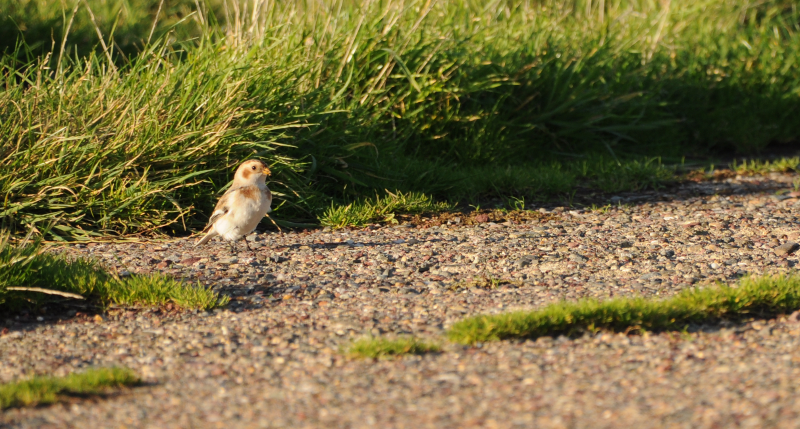
Predictably, just as the birds get into range of my camera, the group decides their comfort radius have been breached, and take off, circling back around to the Northern end of this bit of the service road. The two other birders (who have the shots they want) briefly commiserate with me before taking their leave; I start to walk up to where the buntings landed: If they're anything like Snow Buntings I've seen in the past, they'll be making their way towards me already.
They're still a good distance away when the birder I originally spoke to joins me. He, amusingly, takes my crouching as a cue to ask if I'm taking photos of the foliage. No, no; those five Snow Buntings over there. Five? Yes. Oh. Oh very good. And it turns out that this chap is even more chuffed (Choughed?) to have found them than I am; I feel fortunate to have had the opportunity to put him on to them.
Time and light pulls me on once more - I'd like to have a look at Marloes Sands before the light dulls. I manage to circuit the buntings without disturbing them, and take a few good shots of the beach; the light is perfect, smug. I take one final opportunity to bother the buntings on the way back to the car before starting the journey back to St. David's.
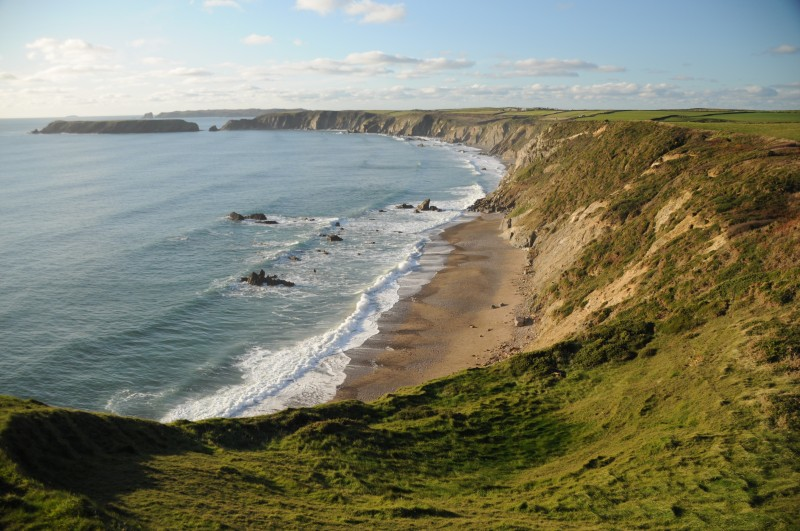
Monday
A later start. Probably something to do with the delicious local beers taken the night before. The weather is still excellent, and so today a slightly longer trek along the coastal path beckons. I head out to Caerfai from St. David's, and start to head East along the coast path from there.
I immediately get stuck on the cliffs just out of Caerfai, because I am being overwhelmed by Chaffinches. A group of perhaps thirty birds tops the cliff and flies just in front of me. By the time I've worked out they're all Chaffinches, another group of roughly the same size, starts to do the same. This continues intermittently for some time; perhaps ten such groups go over in around half an hour. A quick twitter search finds that Ramsey Island RSPB has been seeing something similar; but even so, I'm excited to have dropped into a live viz-mig event!
And they Chaffinches just keep coming! Only a giant group of Linnets near Morfa Common and the occasional Chough distract me from the something like 1,000 birds that flap past me over the next couple of hours. I sit down in the pub in Solva for a pint and some grub wondering if this is just something that happens on the coastline all the time.

In my reverie, however, I neglect to notice that I'm sitting on the nozzle of my water bladder enough for it to be slowly but surely giving me the appearance of a total incontinent. This is uncomfortable enough to shorten the day's plan; a return walk via St. David's Airfield and Dowrog Common is cancelled in favour of a bus back to a dry pair of trousers.
Somewhat later, I head out of St. David's towards Dowrog. My trusty OS map tells me there's a series of footpaths I can take to a road that crosses the common. Various birding sources tell me that, from there, there's a good view of raptors coming in to roost.
The footpaths are sodden, and my walking shoes are very quickly water-logged. Sigh. Oh well. I console myself with the knowledge that the water in my shoes will eventually warm, and provide comfort, like a wetsuit. I consciously avoid thinking about this too much in case it isn't true. The light is considerably less good than at Dale the day before, but the birds I find (Fieldfares, Pheasants, a nice Reed Bunting and a collection of Starlings on some wires) are sufficiently thin on the ground to make me wonder if this was a good idea.
When I eventually reach the road that crosses the common, however, things start to look up. There's a bloke parked up touting a scope - he's not a local, but he's heard that people have seen Hen Harrier here recently (Pembs Birds agrees). I continue along, not wanting to spoil his solitude, and despite the terrain looking about right for a harrier roost...it's not quite open enough here to see everything.
After passing through a tiny wooded area with a house hidden in it (what a place to live!), the common opens up and I suddenly have a near panoramic view. Almost immediately, a Marsh Harrier appears, quarters the common South of the road, before crossing the road (almost perfectly above me), and floating down into the trees there to roost. Ok, good start!
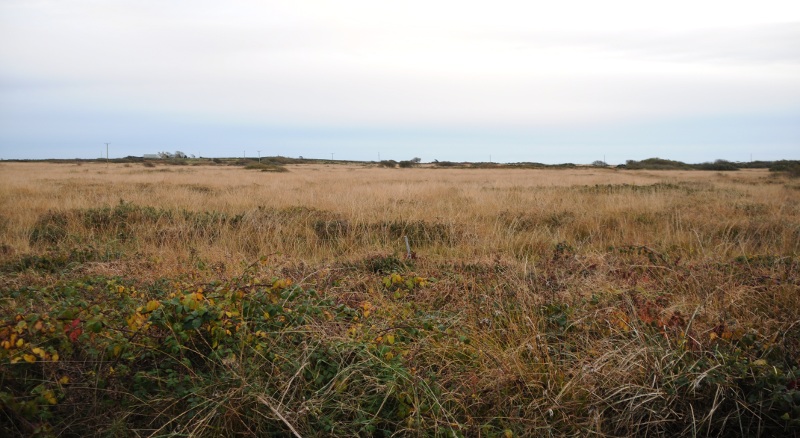
I set up my scope to be able to scan the area where the Harrier set down. And then, for a good half an hour, absolutely nothing happens. I spend more time glancing at the birders I can see at the top of the road for signs of excitement than actually finding anything. Eventually I concede defeat and head up to talk to them; perhaps they've had better luck without showing outward signs of excitement.
They have had a slightly better time - they had a Hen Harrier earlier on, and they were quite excited to see a Marsh Harrier. We have a good chat about good local patches in the area, before they give up and go home for a cup of tea (it's very, very cold, and nearly dark). With the very last photons of light, I think I can pick out a Short-eared Owl in a grassy patch just to the North of the road, but I go boss-eyed trying to get a solid ID; it's just too dark.
Speaking of the dark, it is now total. And I'm a good 3km from home. Probably the least bad way back is along the A487, but that's also in use by traffic, at 50mph, and is free of lighting. So it's a rather frightening half an hour game of phone-light traffic dodging on the way home. Dowrog shows potential though: I resolve, tomorrow, to arrive earlier, and in a car.
After making it home, I check Pembs Birds and discover I have made the news twice, first as a visiting Birder from London, and secondly as a mainland birder. Fame at last.
Tuesday
Following advice from Dowrog's locals, I attempt to visit Pwll Trefeiddan, a pond/lake near St. Justinian. There is, however, nowhere to park, so I give up and resolve to try somewhere else. Later, I realise walking from St. David's would have been just fine. On the way back into St. David's, an obscene number of Jackdaws turns the sky black. Is a murmuration of Jackdaws a thing? It's impressive (and a bit scary) in any case!
I decide to pay a visit to Whitesands Bay, to have a look at St David's Head. I pay £4 for the privilege of parking. Then it's a short but pleasant walk to the head. There's a confiding Chough on the way, and an auk (probably Guillemot) on the water, but little else. A Peregrine Falcon, probably on the way to Ramsey Island, makes a brief appearance while I'm eating a snack on the rocks of the head itself.
Later on I revisit Dowrog Common, claiming the best parking space, and getting set up by 1520ish. This comes with an excellent reward; two male Hen Harriers, and a female as well. At some points, all three birds can be seen in the same view from the scope. The birds skirt around the trees to the North of the common, appearing and disappearing several times across an hour or so. And then, again, nothing. We wait in hope of an end of day Short-eared Owl, but to no avail, the Hen Harriers will just have to do.

Wednesday
A frustrating day, with a trip to Narberth only to discover the bike shop I was hoping to hire a bike from has gone out of business. Back to St. David's. Plan B: let's try and get on the Ramsey boat at 12:00! Nope, cancelled. Plan C: A trip to the Nevern estuary for some waders (another recommendation from the Dowrog locals). It's a long drive, with some interesting diversions in Fishguard, but it's worth it.
The estuary is bridged by the Newport-Moylgrove road, and apart from the central section, the bridge is one-third parking spaces. Great! It's possible to bird from the car a bit here, but it's clear things will be better with a scope from outside. There's a good group of Curlews in the water, plenty of Redshanks, one or two Dunlin, some noisy geese, and a cute Common Redshank.
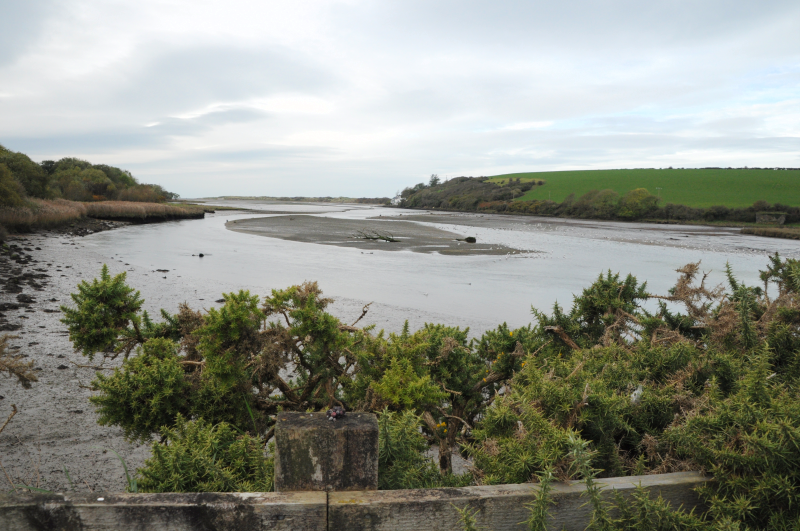
A pair of birders return from a walk along the Northern side of the estuary claiming to have found Ringed Plovers. Not an opportunity to turn down, but a quick expedition doesn't find them. Shame, great birds. On my return though, a Common Kingfisher is posing on the rocks on the inland side of the bridge. Delightful.
There's still a fair chunk of day left. My OS map shows me that the Nevern goes into a steep sided valley that's well treed not far away. Hmm. Dipper country? A bit of Googling suggests so. A swift drive to the village of Nevern later, and I'm on a footpath following the path of the river again. Well, river. Stream. This has got Dipper written all over it. At other times of year I'd be hopeful of flycatcher here, the woodland feels compatible. A pair of Jays flopping about at the edge give me a nearly complete set of UK Corvids for the trip; I'm only short Hooded Crow.
But no immediate Dipper joy. And the path veers away from the water significantly now, making things difficult. The path apparently veers back to the Nevern after a brief sojourn nearer the top of the incline.
Or not. Two sturdy chaps breaking up some wood cheerfully inform me that I'm lost. And that the path I'm on hasn't been a thing for ages, and that the bridge I'm hoping to cross doesn't exist. Well, pants, frankly. They advise me of a minimally intrusive alternative route. I evidently get this wrong, because I end up having to scale a fence to get onto the road that the next existent bridge carries across the stream. It's a good job I've recently watched YouTube epic, "The Mission Across Wales".
Having successfully crossed the stream, I rejoin the existent footpath. This even has signposts. Luxury. I thoroughly check the area where my phantom bridge is supposed to be, and there is, as promised, sod all. Wow! The OS map was wrong! I wonder how you tell them.
The remaining walk is quite hard work - there's a lot of up and down. On the final down section back into the woods, my Dipper radar pings. There's a tiny patch of off-white on some rocks crossing the stream. It is, indeed, a Dipper; I am half terrified and half impressed my subconscious managed to parse that from here. It sits long enough for some terrible photos (to be published in forthcoming feature, "spot the bird") to be taken, before zipping off back in the direction I came.
That's the last thing of interest to happen; a swift return to St. David's follows.
Thursday
The wind has subsided since yesterday, and the opportunity to visit Ramsey island cannot be declined. Even though it probably should be, because, despite the lack of wind, it's misty, rainy, and otherwise thoroughly miserable. Still, I have suitable clothing to cope with this.
But frankly, even with decent clothing, there isn't much to see. There's a young seal pup frolicking near the place the boat drops you off, and the warden is cheerful, and knowledgeable about what's on the island (although, between the lines, I can hear she is telling me that, barring the seals, the birding is a bit sketchy).
There is a Chough or two, a Kestrel and plenty of Ravens, but really what there is, mostly, is a lot of moisture and all of it determined to sit on the lenses of my glasses. Should've worn contacts! I zip round the island walking circuit in record time. In the shop, several other folk are sheltering with cups of tea, and I join them for a birding chinwag. We get talking about other birding islands: The Farnes, mostly; I mention that Handa is also worth a visit (more on both another time). Eventually, it's time to head to the boat. And it turns out that we're going to be the last trip of the year, and we're taking one of the wardens with us, so we all lend a hand helping her get her stuff on to the boat. One lonely chap and his dog are left behind. Hopefully they'll remember to fetch him another day.
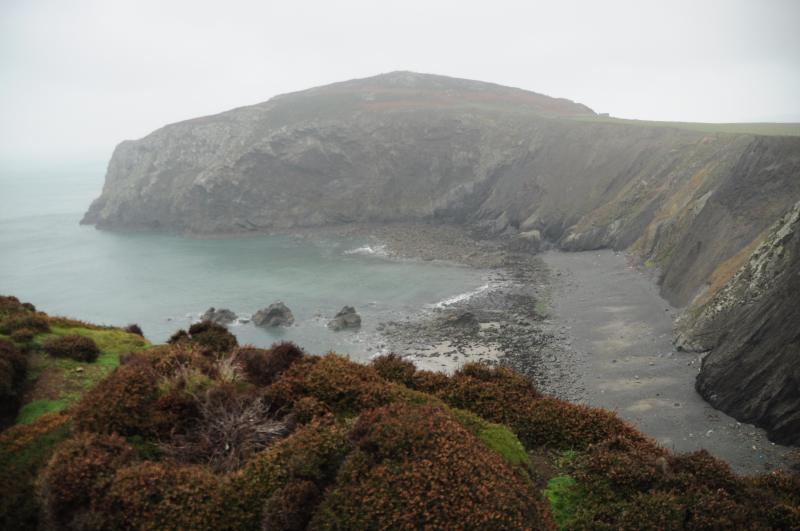
Friday
I finally manage to go surfing - the mixture of weather conditions finally whips up a swell making it worth it. Manage to stand up three times; a small victory for a first outing in more than a year - and unsupervised, for the first time ever.
On return, I hear news that a Firecrest has been seen near the graveyard on the North side of the city. With little else to do other than feel sad about leaving tomorrow, a bit of a search for it feels apt, despite the unpleasant drizzle. And I've never managed to find a Firecrest, and this feels like a small search area.
Immediately I come across a large, roving tit flock. It's a mixture of Long-tailed and Blue Tits, and at least three regulus. Excitement. But they're all Goldcrests. I take the slippery path down from the church towards the cathedral, and further Goldcrests taunt me - there are loads of them! I travel up and down the path a few times, until all signs of the flock have disappeared; I suspect they've moved up along a thick wall that I think turns into part of the wall that surrounds the cathedral. I complete the descent of the slippery path, and take the left turn that takes me into the cathedral grounds. I skirt round the cathedral clockwise, because the seriously chunky wall continues up there.
There are a few trees that have grown either side of the wall, and soon, the flock starts to come into them. Despite increasingly panicked binocular flitting, I still can't find any Firecrest, and, honestly, the light is not quite good enough from this angle to show the supercilium that would help me tell the difference.
To the right of the highest tree, though, something does a flutter from a branch which looks almost flycatchery. Huh? What the hell is that? I eventually pick it up as it sits on top of a handy nearby gravestone, and it's a Black Redstart! And here's me trundling around town without my camera. Sod sod sod. A quick sprint back to accommodation fixes this, at the cost of ten or fifteen minutes' light, and a bead on the bird. When it does turn up again, it isn't comfortable with me being close enough to get a good shot, and various tourists decide that, obviously, the strange bird man must be best served by us walking directly at the bird so it is continually flushed. In the end I give up and take some photos of a much more confiding Grey Wagtail. Still, a nice surprise to end the holiday with.
Retrospective
St. David's is an excellent place to stay, and, at this time of year, Dowrog Common appears to have a decent raptor roost. The coast path is great for Chough and Raven (basically the cliffier the better), and can occasionally yield some visible migration. There is a strong chance of encountering Black Redstart (they were seen at several places along the coast line across the week).
I'm not sure I need to come in November for birding again, but I can see us paying another visit in the Spring, when the islands come alive. St. David's might not be the best base for that; it's good for Ramsey, but less good for Skokholm and Skomer. Perhaps a half/half holiday could work. We will see.